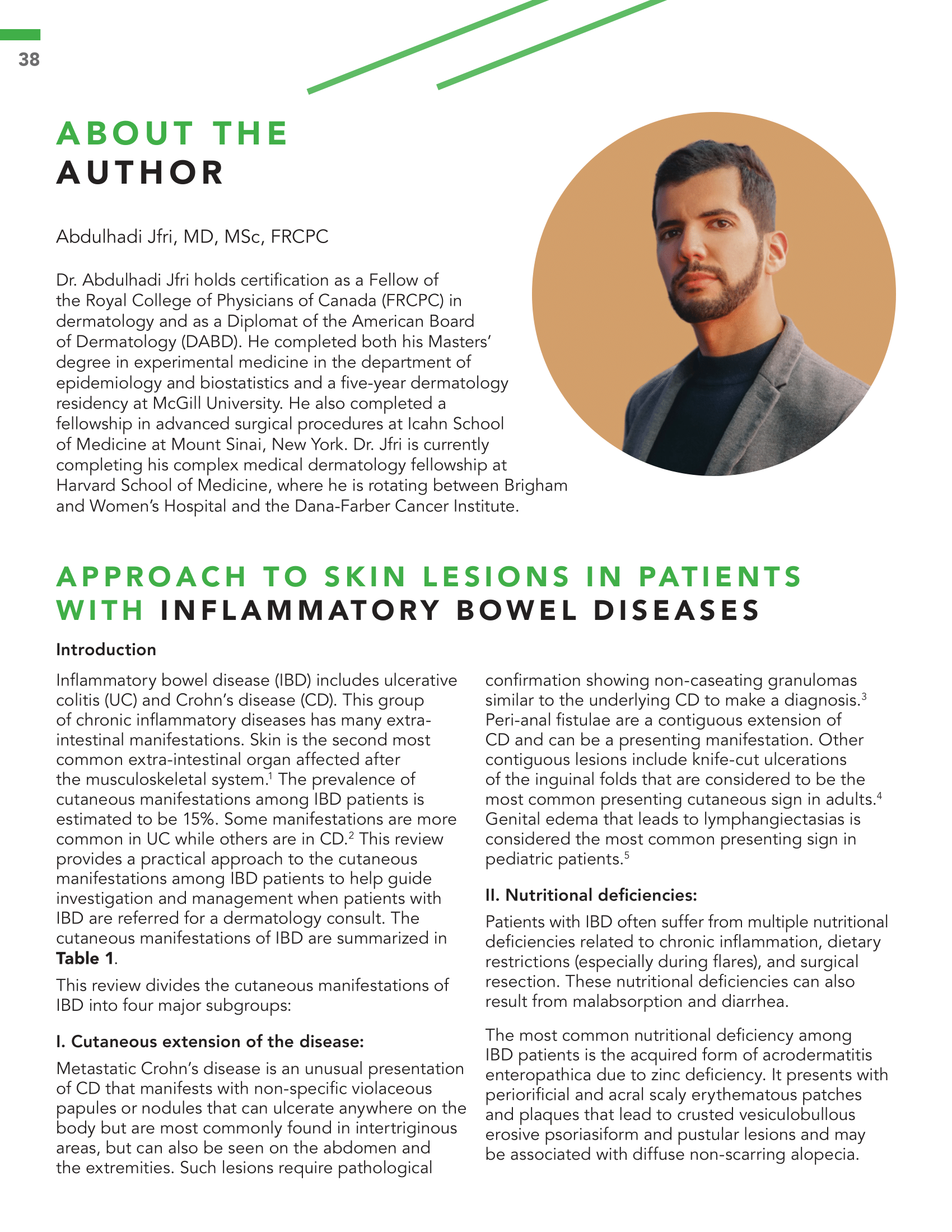Approach to Skin Lesions in Patients with Inflammatory Bowel Diseases
Abstract
Inflammatory bowel disease (IBD) includes ulcerative colitis (UC) and Crohn’s disease (CD). This group of chronic inflammatory diseases has many extra-intestinal manifestations. Skin is the second most common extra-intestinal organ affected after the musculoskeletal system. The prevalence of cutaneous manifestations among IBD patients is estimated to be 15%. Some manifestations are more common in UC while others are in CD. This review provides a practical approach to the cutaneous manifestations among IBD patients to help guide investigation and management when patients with IBD are referred for a dermatology consult.
References
Kethu SR. Extraintestinal manifestations of inflammatory bowel diseases. J Clin Gastroenterol 2006;40:467-475.
Vavricka SR, Brun L, Ballabeni P, et al. Frequency and risk factors for extraintestinal manifestations in the Swiss inflammatory bowel disease cohort. Am J Gastroenterol 2011;106:110.
Burgdorf W. Cutaneous manifestations of Crohn’s disease. J Am Acad Dermatol 1981; 5:689.
Yüksel I, Başar ., Ataseven H, et al. Mucocutaneous manifestations in inflammatory bowel disease. Inflamm Bowel Dis. 2009;15(4):546-550. doi:10.1002/ibd.20807
Palamaras I, Pietropaolo N, Thomson P, Mann S, Robles W, Stevens HP. Metastatic Crohn’s disease: a review. J Eur Acad Dermatology Venereol. 2008;22(9):1033-1043. doi:10.1111/j.1468-3083.2008.02741.x
Sehgal VN, Jain S. Acrodermatits enteropathica. Clin Dermatol. Nov-Dec 2000;18(6):745-8. doi: 10.1016/s0738-081x(00)00150-4.
Maria O’Sullivan, Colm O’Morain. Nutrition in inflammatory bowel disease. Best Pract Res Clin Gastroenterol. 2006;20(3):561-73. doi: 10.1016/j.bpg.2006.03.001.
Lankarani KB, Sivandzadeh GR, Hassanpour S. Oral manifestation in inflammatory bowel disease: a review. World J Gastroenterol 2013;19:8571–8579.
Farhi D, Cosnes J, Zizi N, et al. Significance of erythema nodosum and pyoderma gangrenosum in inflammatory bowel diseases: a cohort study of 2402 patients. Medicine (Baltimore) 2008; 87:281.
Wei-Ti Chen, Ching-Chi Chi. Association of Hidradenitis Suppurativa with Inflammatory Bowel Disease: A Systematic Review and Meta-analysis. JAMA Dermatol. 2019 Sep; 155(9): 1022-1027
Travis S, Innes N, Davies MG, et al. Sweet’s syndrome: an unusual cutaneous feature of Crohn’s disease or ulcerative colitis. The South West Gastroenterology Group. Eur J Gastroenterol Hepatol 1997; 9:715.
Truchuelo MT, Alcántara J, Vano-Galván S, et al. Bowel-associated dermatosis arthritis syndrome: another cutaneous manifestation of inflammatory intestinal disease. Int J Dermatol 2013; 52:1596.
Akbulut S, Ozaslan E, Topal F, et al. Ulcerative colitis presenting as leukocytoclastic vasculitis of skin. World J Gastroenterol 2008; 14:2448.
Chiu G, Rajapakse CN. Cutaneous polyarteritis nodosa and ulcerative colitis. J Rheumatol1991; 18:769.
Iwata, Hiroaki, et al. “Meta-analysis of the clinical and immunopathological characteristics and treatment outcomes in epidermolysis bullosa acquisita patients.” Orphanet journal of rare diseases 13.1 (2018): 1-9.
Keyal, U.; Liu, Y.; Bhatta, A.K. Dermatologic manifestations of inflammatory bowel disease: A review. Discov. Med. 2018, 25, 225–233.
Yi-Ju Chen, Chao-Kuei Juan, Yun-Ting Change et al. Association between inflammatory bowel disease and bullous pemphigoid: a population-based case–control study. Sci Rep. 2020; 10: 12727.
Paige DG, Leonard JN, Wojnarowska F, Fry L. Linear IgA disease and ulcerative colitis. Br J Dermatol. 1997;136:779–782.
Yun Fu, Cheng-Han Lee, Ching-Chi Chi. Association of Psoriasis With Inflammatory Bowel Disease: A Systematic Review and Meta-analysis. JAMA Dermatol. 2018 Dec 1;154(12):1417-1423. doi: 10.1001/jamadermatol.2018.3631.
Ko JM, Gottlieb AB, Kerbleski JF. Induction and exacerbation of psoriasis with TNF-blockade therapy: a review and analysis of 127 cases. J Dermatolog Treat. 2009;20(2):100–108
Karolyn A Wanat, Rosalie Elenitas, Sam Chacklin et al. Extensive lichen nitidus as a clue to underlying Crohn’s disease. J Am Acad Dermatol. 2012 Nov;67(5):e218-20. doi: 10.1016/j.jaad.2012.04.005.
M P Tighe, R A Morenas, N A Afzal, et al. Erythema ab igne and Crohn’s disease. Arch Dis Child. 2008 May;93(5):389. doi: 10.1136/adc.2008.137968.
Ariyaratnam J, Subramanian V. Association between thiopurine use and nonmelanoma skin cancers in patients with inflammatory bowel disease: a meta-analysis. Am J Gastroenterol2014; 109:163.
Singh S, Nagpal SJ, Murad MH, et al. Inflammatory bowel disease is associated with an increased risk of melanoma: a systematic review and meta-analysis. Clin Gastroenterol Hepatol 2014; 12:210.


